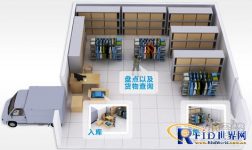
RFID Warehouse Management System—Apparel Industry
[ad_1]
1. Product overview:
Tianjin Little Bee CompanyRFIDThe clothing warehouse management system integrates RFID technology on the basis of warehouse management software, and introduces RFID technology into the existing clothing warehouse management, which can inspect, warehousing, outgoing, allocating, shifting, and inventory of clothing warehouses. Automated data collection is carried out on the data of each operation link such as inventory, to ensure the speed and accuracy of data input in each link of warehouse management, to ensure that the company can timely and accurately grasp the real data of the inventory, and reasonably maintain and control the company’s inventory.

2. System design:
The clothing warehouse management system based on RFID technology is an extension and application expansion of the Internet and communication networks, and is a highly integrated and comprehensive application of a new generation of information technology.

In terms of system design, we follow the brand concept of “Solving the heart and simplicity”. Committed to providing RFID warehouse management solutions with the lowest total cost of ownership for small and medium-sized enterprises through a new product operation model. In terms of product model, we will provide multi-level product versions such as standard version, enterprise version and customized version of RFID clothing warehouse management to meet the diversified needs of customers. These different versions will be launched one after another in the development of our products. In the overall solution, we bring life cycle management services into the entire product service link, from planning and design, to installation and implementation, to maintenance support, we provide overall solutions.
RFID clothing warehouse management products are based on B/S architecture, which can satisfy customers’ quick work and access in the local area network and ensure real-time performance. In architecture design, we attach great importance to the layering of the architecture, adopting the concept of distributed isolation, in order to facilitate future upgrades. In terms of specific functional modules, we focused on optimizing the processing of warehouse management, and deleted some traditional cumbersome functions. We are committed to applying RFID technology to workflow and inventory control in the simplest and most effective way.
In addition, we attach great importance to user experience. For example, the design of the software interface is based on simple and practical principles and optimizes the operation of human-computer interaction information as much as possible, so that the entire system functions can be visualized, simplified, and organized to easily complete all warehouse management tasks.
3. RFID application value
With the development of society and modern science and technology, the apparel industry is facing fierce competition and rising customer expectations. The realization of comprehensive and reliable information management is a sign of modern clothing warehouse management and level. Traditional inventory management methods have great difficulty in standardizing and scientific management of warehouse management due to the uneven distribution of goods and heavy workload in the warehouse.

As the core technology in the Internet of Things, RFID is also the most widely used in warehousing and logistics supply chain management. The clothing industry is one of the most potential application areas of RFID. The changes brought about by RFID technology are not far away from us, and will be widely used in various fields. With the rapid development and integration of information technologies such as the Internet of Things, mobile Internet, and cloud computing, we may reimagine the construction of our business and IT systems in this era.
The main advantage of RFID warehouse management system over other types of identification systems (barcode identification) lies in its non-contact data collection and radio frequency tag read/write operations. High recognition rate, strong adaptability, resistance to light, temperature, humidity, dust, grease, and chemical reagents are also the reasons why RFID warehouse management systems are particularly suitable for use in special environments in various industries.
Clothing warehouse management software combines RFID technology for data collection and daily business management, establishes a clothing information RFID management platform, supports important business processes of clothing warehouse management, and improves the efficiency of core business processes such as warehousing, outgoing, and inventory. Effect. Realize automatic identification, information sharing and tracking, and bring improvements in productivity, accuracy, profitability and customer service.
4. System function:

1. Warehouse management
There are two ways to use RFID to collect data for warehousing management: In the first way, you can use a desktop card issuer to enter RFID tag information, and then attach the tag to the goods. The second way is to use an RFID handheld terminal to perform RFID tag writing and reading operations.

2. Outbound management
According to the clothing delivery plan, the RFID handheld terminal is used to scan the goods to be out of the warehouse for data collection and out of the warehouse management. The collected data is transmitted to the background database through the wireless local area network for data synchronization and update.

3. Inventory management
Count the quantity of goods in the inventory, including the quantity out of the warehouse, the quantity in the warehouse, and the quantity of goods that can be queried according to the date. Use RFID handheld terminal to quickly realize inventory management, and compare it with the information in the database, and provide inventory staff for verification.

4. Inventory information management
Check the status of inventory information, including inventory entry, delivery, inventory information management, and inventory information inquiries under various conditions. The warehouse can also be divided into locations, so that the management of large warehouses can be more accurate.
5. System security
The system provides a complete login program (user name and password). Different personnel are given different permissions, which are set by the system administrator. The system also provides a one-key data backup and recovery function, which further ensures the security and continuity of business data.
[ad_2]






